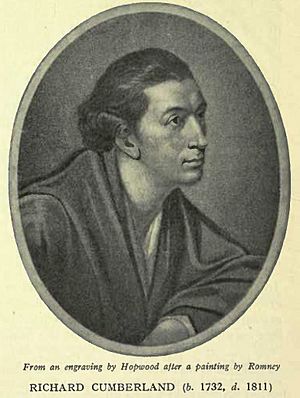Richard Cumberland (dramatist) facts for kids
Quick facts for kids
Richard Cumberland
|
|
|---|---|

detail of an oil painting by George Romney
|
|
| Born | 19 February 1732 Master's lodge, Trinity College, Cambridge, England |
| Died | 7 May 1811 (aged 79) London, England |
| Occupation | Dramatist |
| Nationality | British |
Richard Cumberland (born February 19, 1732 – died May 7, 1811) was an English writer and government worker. He is best known for his plays. In 1771, his play The West Indian became very popular.
During the American War of Independence, he secretly tried to make peace with Spain. He also started a short-lived magazine called The London Review. His plays often showed characters who were not usually the main heroes, like people from different backgrounds.
Contents
Early Life and School Days
Richard Cumberland was born on February 19, 1732, in Trinity College, Cambridge, England. His father, Denison Cumberland, was a clergyman who later became a bishop. His mother, Johanna Bentley, was the daughter of a famous scholar named Richard Bentley. Richard also had a younger sister, Mary Alcock, who became a poet.
Richard went to school in Bury St Edmunds. Later, he moved to the famous Westminster School. There, he studied with other students who became well-known, like Warren Hastings and William Cowper.
At 14, Richard went to Trinity College, Cambridge. He finished his degree in 1750. He was a very good student, ranking tenth in his class.
Working for the Government
After college, Richard Cumberland started working for the government. He became a private secretary to the Earl of Halifax, who was in charge of trade. This job still gave him time to write.
In 1759, he married his cousin, Elizabeth Ridge. He then got a job as a "crown-agent" for Nova Scotia.
In 1761, Richard went to Ireland with Lord Halifax. Halifax became the leader of Ireland, and Richard got a job as his secretary. He was even offered a special honor, but he said no.
Later, he worked for the Board of Trade and Plantations. He held this job until 1782, when the government changed.
Secret Mission to Spain
In 1780, Richard Cumberland went on a secret mission to Spain. His goal was to make a separate peace deal during the American War of Independence. This was meant to weaken the countries fighting against Britain.
He was welcomed by the King of Spain, Charles III of Spain. However, they could not agree on who should control Gibraltar. So, the peace talks failed.
Richard was called back to England in 1781. The government refused to pay him back for his travel costs. He lost a lot of his own money, about £4500, and never got it back. Soon after, he lost his government job.
He then moved to Royal Tunbridge Wells. In his later years, he lived mostly in London. He passed away there and was buried in Westminster Abbey.
Writing Life
Cumberland wrote many things, but he is best remembered for his plays and his memoirs (a type of autobiography). His friends helped him write and publish his memoirs. He also wrote essays, poems, and religious pieces. He even started a magazine called The London Review.
He wrote 54 plays in total. About half of them were comedies. He often wrote "sentimental comedies." These plays had everyday stories, taught moral lessons, and included humor. He liked to show characters from different parts of the British Empire, like Scots, Irish, and colonials. He wanted to show their good qualities.
His plays were very patriotic and followed traditional morals. While his dialogue might not have been brilliant, his plots were usually well-made. He understood how to make a play exciting for the audience.
His first play was a tragedy called The Banishment of Cicero (1761). His first successful comedy was The Brothers (1769). This play was inspired by Henry Fielding's Tom Jones.
His most famous play was The West-Indian (1771). The main character is a young man from the Caribbean who is a bit wild but has a good heart. This play was very popular and was even translated into German. The famous writer Johann Wolfgang von Goethe acted in it.
Richard Cumberland published his memoirs in 1806–07. The artist George Romney painted his portrait, which is now in the National Portrait Gallery.
Some of His Plays
- The West-Indian (1771) - His most famous comedy.
- The Fashionable Lover (1772) - A sentimental comedy.
- The Choleric Man (1774) - Another comedy.
- The Carmelite (1784) - A romantic drama.
- The Jew (1794) - A drama that was very popular.
- The Wheel of Fortune (1795) - Featured a well-known character named Penruddock.
His Novels
- Arundel (1789)
- Henry (1795)
- John de Lancaster (1809)
Images for kids
See also
 In Spanish: Richard Cumberland para niños
In Spanish: Richard Cumberland para niños




